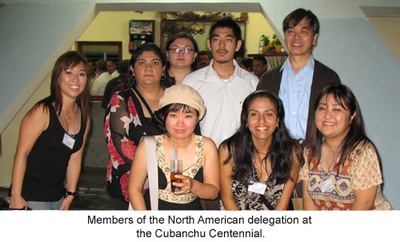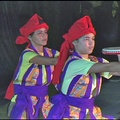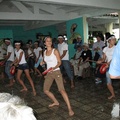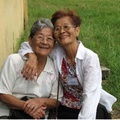> Part 1
HAVANA
We arrived at Jose Marti International Airport in Havana in the late afternoon of Oct. 23. As we exited the terminal, we were greeted by a welcoming committee carrying the flags of Okinawa prefecture and Cuba. Their faces were filled with smiles and they carried a banner that read in part: “Ichariba chode chimi churasa” — Okinawan for “Once we meet we are brothers and sisters. Beautiful spirits.” “Cuba e youkosou” — Japanese for “Welcome to Cuba.”
We were introduced to Antonio Yohena, president of the Cuba Okinawa Association, and members of the Mexico delegation who helped plan the event.
As I stepped out of the airport, I was immediately struck by how much Havana looked like Hawai‘i. There was so much greenery; there was even red dirt! The climate was much like Hawai‘i’s — humid with light breezes. There was also a certain calmness: no sounds of heavy traffic or other big-city distractions; it was peaceful. I was thousands of miles away from home in a foreign country, but it didn’t feel like it at all.
Jesus Garcia was our English-speaking guide throughout our trip. He grew up in east Havana and became an English professor after graduating from the University of Havana. He explained that during the collapse of the Soviet Union in the early 1990s, Cuba experienced a severe economic depression. Cubans refer to it as the “Special Period.” The Soviet Union had been a major source of aid to Cuba, providing economic, trade and military support. Without that support, the Cuban economy was extremely limited. For the Cuban government, foreign capital in the form of tourism — mainly from Canada and Europe — was a way out of economic hardship for the island nation.
As tourism grew in Cuba, many professionals found it a more lucrative occupation. As doctors, lawyers, professors, they earn only about $10 to $12 a month in U.S. dollars. Tour guides, however, receive tips from tourists amounting to hundreds of dollars.
Jesus’ candor about his country provided valuable insight into this island nation. I had imagined that Cubans would be so loyal to their government that they would despise Americans. That wasn’t the case at all. Jesus made it clear that while they may oppose the actions of the U.S. government, they do not hate Americans. Jesus noted that education, from primary to higher education, is subsidized by the Cuban government, so it’s not unusual to see Cubans in heated debates over politics and other issues.
I was curious to see how men and women function in the workplace in a socialist republic like Cuba. Inequality continues to exist in America, in spite of government regulations. According to Jesus, the Cuban Revolution of 1959 sought to erase gender inequality. He said women and men have the same opportunities in education and career choices and gave me some statistics from the Federation of Cuban Women.
The current level of literacy among Cuban women is 99.6 percent. Women comprise 63.8 percent of general doctors and 51.6 percent of researchers. They make up 72 percent of the educational field. Seventy-one percent of Cuba’s lawyers are women. Interestingly, the average marriage rate (per 1,000 marriages) is 4.5. Abortion is legal and free, and mothers and fathers can take a leave of absence until their baby is a year old.
On our first night, Jesus took us to a restaurant in Havana where he often takes his tour groups. It was our first authentic Cuban dinner. The restaurant, a fairly large one, is known for its chicken dinner. Those of us who were not vegetarian, enjoyed a delicious meal of black beans, rice with chicken gravy and a sautéed chicken breast.
I don’t recall seeing a restaurant sign, but I did see a large, almost overpowering sign at the entrance hailing the “Cuban Five.” These five men, all Cuban nationals, were arrested in Miami in 1998 and convicted of spying on behalf of the Castro regime. All five are currently serving prison terms in the United States. One of the men, Geraldo Hernandez, was also convicted of “murder conspiracy” in the deaths of four Miami-based pilots whose civilian planes were shot down by a Cuban missile in February 1996. In Cuba, billboards like these hail them as heroes. Nearly every street corner or wall is plastered with a mural or a billboard praising the current regime, the revolution or heroes of the revolution.
We spent the next day sightseeing on our own, visiting a cemetery where many Nikkei (person of Japanese ancestry born outside of Japan) are buried. A two-story mausoleum houses generations of families with names like Uchiyama, Harada and Ito. According to a caretaker, Nikkei are laid to rest in plots on the cemetery grounds and later added to the mausoleum.
The visit to the Nikkei cemetery was followed by a few more hours of sightseeing, visiting places tied to Cuba’s history: the Museo de la Revolucion (Museum of the Revolution) and the Memorial Granma, both housed in the former presidential palace built by former Cuban President Fulgencio Batista. He had the palace built using marble and ornate decorations by Tiffany. The Museum of the Revolution contains artifacts used during that period. Items such as weapons, a blood-stained shirt worn by Fidel Castro and photos tell the story of the planning and execution of the revolution by Castro, Che Guevara and other revolutionaries. The Memorial Granma is the boat that Castro and the others used to return to Cuba from exile in Mexico in 1956.
That night, we had the opportunity to meet and socialize with members of the Okinawa and Brazil delegations and some Cubanchus. Cuba Okinawa Kenjinkai president Antonio Yohena hosted a party at the home of his mother, who is Cuban. We were greeted graciously at the door by Antonio, his wife and other family members and given handmade gifts. In the backyard was a table full of food: pizza, ham, cheese and other appetizers, a fruit salad, two cakes. Beer and rum flowed throughout the night. It seemed like the kind of festive party we would host in our own homes — until it was pointed out that the spread of food and drink was beyond the means of average Cubans.
Their food rations are proof that Cubans are adept at dealing with challenges. A family’s monthly ration of basic food items includes less than a dozen eggs, a few pounds of sugar (white and brown), about 5 pounds of rice and beans, a small amount of cooking oil and a bread roll for each day. One liter of milk is available for children up to age 7. They can usually get a limited amount of pork or fish; beef, however, is rare. If a family uses up its rations before the end of the month, they must purchase them, which is very expensive. Hotels, on the other hand, are provided enough pork, fish and beef by the government to serve to tourists. With these sobering facts learned, we left the party and returned to the hotel.
* This article was originally written as a special to The Hawai‘i Herald.
© 2008 Lesley Chinen






